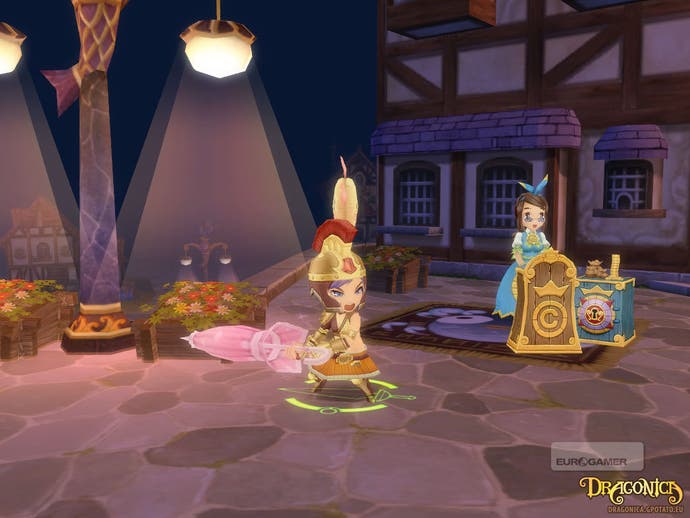Dragonica
It does drag on.
Playing a game like Dragonica - an unbearably cute, free-to-play, 2.5 dimensional side-scrolling MMO, with strong non-European teen appeal - you don't expect innovative storytelling. You expect fairy tales. Forces of darkness, once-defeated, and regathering power. It's such an over-used theme that it's rocketed past cliché and into Fantasy Truism, from teen-lit like Harry Potter to "adult" fantasy like Dragon Age; somewhere, something evil is bitterly nursing its wounds, and preparing its apocalyptic return. But that's OK - while the dark forces are gathering power, it gives our hero a chance to go through a series of training montages. And what is an MMO, if not an infinite training montage?
Dragonica describes itself as closest in style to MapleStory. Actually, that's selling itself a little short. MapleStory is a 2D platformer at heart, and Dragonica has very little platforming. Some of the later levels have you jumping from one small platform to the next, but the inclusion of an icon on the floor under your character removes any of the guesswork about where you'll land. It's more Golden Axe than Super Mario.
It's also a more fully-realised and good-looking 3D world. It's a bit of an illusion - you're mostly limited to left and right movement, with backwards and forwards adding stripes of literal depth to the combat. Meanwhile, exploration is made a little less linear thanks to the Hyper-Jump pads, which spring you to another horizontal stretch of terrain. It can be briefly disorientating, but it would be desperately boring without them.
The first thing you'll do is to choose a class. There are two ranged fighters (the magician and the ranger) and two melee classes (the fighter and the thief). Customisation options include two genders, 10 hairstyles, 20 hair colours, and 10 faces, but only your class has an effect on the game. That extends to character development, too; levelling up boosts your stats automatically, leaving you with discretion only in how to spend your skill points on your class tree. A positive spin would be to call it accessible and fuss-free, but the truth is it's as shallow a character creation process as Gauntlet.

I keep mentioning eighties arcade games. That's because it's the most powerful vibe Dragonica gives off. If MapleStory was Wonder Boy, Dragonica is a saucer-eyed Renegade. It's a sideways scrolling beat-em-up first, with MMO trappings strapped on as a compulsive second. Right down to the "this way!" icon that flashes at the right of the screen when you've killed all the enemies in a mission zone, it's basically Final Fight with more moves and inventories.
It's such an arcade game that gPotato recommended that I play on a pad. There are tutorials on the official site on how to set it all up, and I'm told that people play the game with SNES, 360 and even Jaguar controllers. When you notice the automatic mappings of your combat fundamentals, it makes perfect sense. Jump, attack, special and air (C, X, A, Z) moves form the basics of all the classes, with typical arcade combos triggering other attacks. Jump-attack triggers your aerial attack (which you can also trigger manually with a hotkey, if you're utterly determined to play in an MMO style) and jump then down-attack triggers your ground attack. Meanwhile, the dash attack is intuitively sparked by double-tapping left or right and quickly attacking. Other skills from the talent tree can be hotkeyed across Q-R and S-F, but you don't really need to use them all - map your most used attacks to the spare buttons on your controller, and you've got an immediately accessible arcade fighter with only a very light RPG element forcing you back to the keyboard.

The combat works simply - enemies are either on the ground, stunned, or flying incapacitated through the air. On the ground, they can be chipped away by your basic, no-mana-cost attack, blasted with a strong attack on cooldown, or launched into the air with your class's special attack. Once you level up, you'd be well advised to invest in an attack designed for enemies in the air; it's a game basic, and will let you decimate the enemies while they're airborne and harmless.
The problem with analogies to games like Double Dragon amd Final Fight is the fundamental shape of Dragonica. Those games started easy, quickly got hard, and you died. But you got better, so every time you played you got a little bit further, and the overall idea was to finish the game. When you take that mechanic and flatten the difficulty curve, remove death and eliminate the end, it robs the gameplay of an important essence. A more serious problem is the repetition of enemy attack styles: the Level 40 zones are split between the same missile and melee monsters as the Level 10 areas, leaving you with a very dim sense of real progress beyond the amount of times you die.








